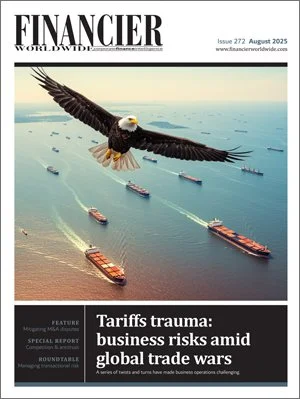Shifting gears: a new approach to merger control policy in the UK and US
August 2025 | SPECIAL REPORT: COMPETITION & ANTITRUST
Financier Worldwide Magazine
To boost economic growth, governments on both sides of the Atlantic are reviewing their approach to merger control and antitrust policy, anticipating that a more favourable regulatory environment for beneficial M&A activity will unlock deal demand.
Since their elections in 2024, Donald Trump’s and Keir Starmer’s respective governments have made clear their intention to foster a more pro‑business regulatory environment and have engaged their respective competition agencies in this agenda.
Andrew Ferguson, the recently appointed chair of the Federal Trade Commission (FTC), has championed “staying in our lane” and taking a less expansive view on the FTC’s role in policing benign transactions. Gail Slater, the new assistant attorney general for antitrust at the Department of Justice (DOJ), has taken a similar stance.
In the UK, Keir Starmer’s government is likewise pushing the UK’s competition regulator, the Competition and Markets Authority (CMA), to pursue a regulatory agenda that supports and attracts investment by streamlining policies and updating guidance.
The pro‑growth agenda
On 15 May 2025, the UK government published its ‘Strategic Steer’ to the CMA; a policy document setting out the government’s priorities for the regulator. This makes it explicit that the CMA should create a pro‑investment regulatory environment. The government has indicated that it wants the CMA to “prioritise growth” and use its tools “proportionately”; being less interventionist where possible and focusing on the most competitively harmful mergers.
The CMA has responded with policy revisions and consultations on its mergers guidance, including amending its approach to merger remedies, taking a ‘wait and see’ approach to global deals and its interpretation of the material influence and share of supply tests, to increase transparency and predictability of how these concepts will be applied to take jurisdiction over transactions.
Sarah Cardell, chief executive of the CMA, has announced proposals to streamline the regulator’s approach in accordance with four key principles: pace, predictability, proportionality and process. The proposals include tighter key performance indicators for the CMA’s merger reviews, such as reducing the target for decisions on straightforward phase one cases from 35 to 25 working days. Similarly, the CMA’s recently published ‘Mergers Charter’ outlines “clear principles and overarching expectations” regarding engagement with businesses throughout the merger review process.
President Trump’s removal of the FTC’s two Democratic commissioners, a move both have challenged, and appointment of Andrew Ferguson as chair, suggests a similar mandate for the FTC. On 15 May 2025, during congressional testimony, Mr Ferguson criticised his predecessors as, at times, having an “ideological bent against mergers and acquisitions” and indicated the FTC under his chairmanship “has no interest in being a roadblock or even a speed bump for M&A transactions that do not present competition issues”.
Praising stability and the need to avoid regulatory whiplash, since taking office, Mr Ferguson has committed to retaining the ‘2023 Merger Guidelines’ implemented under the previous administration. However, he has also indicated a desire to streamline merger reviews and “get out of the way” where there are not serious competition issues.
It appears the FTC under the second Trump administration will largely revert to traditional ‘conservative’ antitrust, focusing on fostering a more pro‑business regulatory environment and targeting mergers that create traditional competition concerns such as price increases. This was seen in the first FTC merger challenge under the new administration, GTCR BC Holdings’ acquisition of Surmodics.
The FTC employed a traditional horizontal theory of harm to challenge a merger which would potentially create an entity controlling more than 50 percent of the market for outsourced hydrophilic coatings (applied to medical devices to reduce surface friction and increase manoeuvrability in the body). Abigail Slater, assistant attorney general for the antitrust division, has indicated similar intentions.
While Ms Slater’s ‘America First Antitrust’ policy statement appears to blend the traditionally conservative approach of Mr Ferguson with a more economic populist approach, it also emphasises the importance of adherence to legislation and precedent over novel theories in antitrust enforcement and a preference for “litigation over regulation” to minimise distortions to the free market.
Merger remedies
Both the CMA and the FTC are assessing their respective approaches to merger remedies, with the intention of quickening the process for agreeing remedies, promoting effective compliance monitoring and reducing costs and time for businesses, to promote a more favourable regulatory environment.
Historically, the CMA has been sceptical of behavioural remedies (where parties commit to specific actions or restrictions on future conduct to alleviate competition concerns, (e.g., price caps or interoperability)), with a strong preference for structural solutions (such as divestiture). A consultation on merger remedies launched in March 2025 suggests the regulator is preparing to depart from this.
While it is still considering its new remedies guidance, the CMA already appears to be operating with greater willingness to accept non‑structural remedies. In its December 2024 Vodafone/Three decision, the CMA sought to address concerns using a package of behavioural remedies that included price‑caps and commitments to invest.
In the same consultation, the CMA is seeking views on how it can use phase one remedies more efficiently and frequently. The CMA has expressed willingness to accept more complex remedies at an earlier stage in the merger review process, reducing the length and cost of merger reviews even in complex cases. This is again a policy which the regulator already appears to be implementing, with the CMA expected to accept phase one divestment proposals by the parties in Schlumberger/ChampionX in a review that would historically have been expected to have gone to a phase two consideration.
Mr Ferguson indicated that the FTC would be looking at merger remedies as an area of reform that could boost economic activity. He has said he will depart from predecessor Lina Khan’s preference for prohibition and would be more willing to consider divestitures or behavioural remedies.
In his 15 May congressional remarks, Mr Ferguson stated that this “includes the possibility that the parties could resolve the FTC’s concerns” before resorting to litigation. This could reduce the costs and timescales for implementing mergers that may raise competition concerns but that may nevertheless be permitted under US merger control rules with modifications.
Focusing on problematic mergers
Despite Mr Ferguson and Ms Slater criticising their predecessors’ perceived antipathy toward mergers, both have maintained a public commitment to the importance of appropriate intervention to ensure that consumer harm is limited. In particular, both have indicated their efforts are likely to be focused on specific markets of concern, namely healthcare and Big Tech.
While Mr Ferguson has suggested that he will generally take a more conservative approach to enforcement, he has linked economic power in Big Tech to non‑economic consumer harms such as censorship. Ms Slater has similarly suggested, in her congressional confirmation, that she will pursue Big Tech beyond traditional theories of harm, including censorship. This suggests that while the respective agencies will be less broadly interventionist than under the Biden administration, with greater focus on traditional theories of harm, they will take an aggressive and potentially novel approach to Big Tech.
Similarly, the CMA has indicated it intends to pursue a lighter touch approach to multijurisdictional deals involving global markets; publishing a consultation on 20 June 2025 on updated guidance, which includes an expanded ‘wait and see’ approach where other competition authorities are already reviewing a transaction, reducing the potential for diverging outcomes where multiple regulators review transactions involving wider than national markets. The same 20 June consultation includes clarifications to the ‘share of supply’ and ‘material influence’ tests, which will increase certainty as to which transactions fall within its jurisdiction.
The CMA and FTC have both indicated a desire to more effectively ascertain the most problematic mergers. According to Mr Ferguson, the FTC’s new mergers form, designed under the Biden administration and introduced in January 2025 and requiring significantly more information to be provided up front, will “identify proposed acquisitions that warrant an in‑depth investigation quickly and confidently”, enabling non‑problematic mergers to proceed more quickly.
The CMA is likewise promoting a more targeted approach that will centre its enforcement around mergers with the greatest risk of anticompetitive effects.
What does this mean for investors?
Ms Cardell, Mr Ferguson and Ms Slater have indicated they wish to reduce the number of mergers being blocked, but that competition enforcement must remain vigorous, particularly in sectors where consumer harm is most likely. This converging approach suggests that in both the US and the UK, more mergers will ultimately proceed without significant antitrust intervention and that, in most cases, investors can deploy capital with fewer concerns that their investment will be subject to lengthy review or litigation.
It is notable that the reforms are not large structural or legislative changes, but amendments to the existing system to streamline merger process, promote faster review of non‑problematic mergers and focus resources where regulators see the greatest risk of consumer harm. The CMA, FTC and DOJ appear aligned on fostering a system that, for most cases, provides greater certainty and tests fewer speculative theories of harm. This will enhance predictability of outcomes and, as it is hoped, promote deal activity.
Although this may result in a somewhat more hands‑off approach to antitrust enforcement overall, for cases that raise competition issues, investors should consider merger remedies and potential efficiencies proactively upfront. Greater willingness to streamline review and accept remedies, including at an earlier stage, enables parties to frontload antitrust analysis and the development of arguments and evidence that the transaction does not warrant in‑depth review or litigation.
Where they can effectively engage the regulators upfront, dealmakers are likely to gain competitive advantage, guiding their investments through a complex but increasingly pro‑growth and deal‑friendly transatlantic antitrust framework.
John Ingrassia and Mary Wilks are partners and Calum Paton is an associate at Proskauer. Mr Ingrassia can be contacted on +1 (202) 416 6869 or by email: jingrassia@proskauer.com. Ms Wilks can be contacted on +44 (0)20 7280 2180 or by email: mwilks@proskauer.com. Mr Paton can be contacted on +44 (0)20 7280 2038 or by email: cpaton@proskauer.com.
© Financier Worldwide
BY
John Ingrassia, Mary Wilks and Calum Paton
Proskauer
Q&A: Navigating dynamic competition in merger control
Shifting gears: a new approach to merger control policy in the UK and US
No deal too small: navigating US and EU scrutiny of below-threshold deals
US, UK and EU decisions buoy antitrust cartel enforcement in labour markets
Antitrust and information exchange: navigating without a safe harbour
The strategic shift in private enforcement of Canada’s competition laws
Legitimate cooperation vs anticompetitive agreements – ‘Green Deal’ or ‘Green Cartel’?
Priorities of the Belgian Competition Authority for 2025: an ambitious programme


